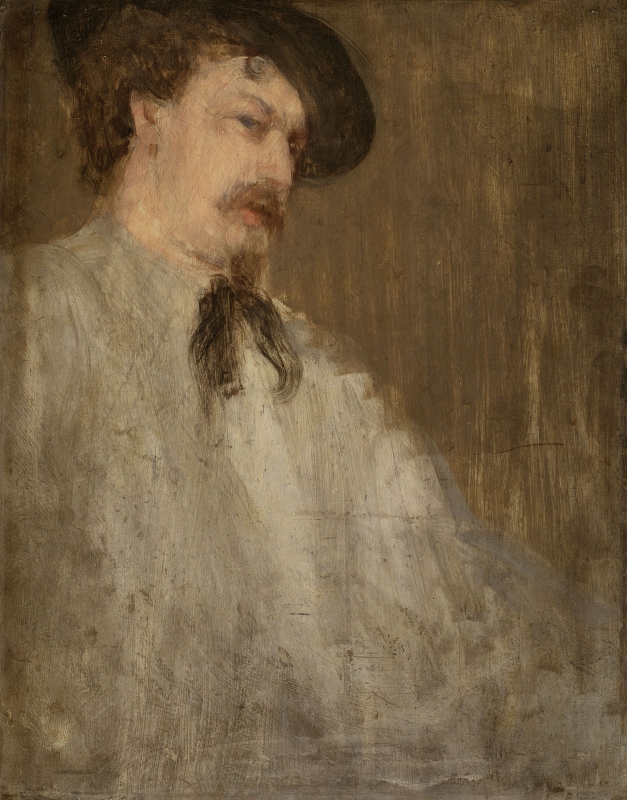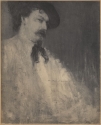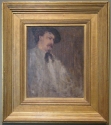Home > Catalogue > Browse > Portrait of Dr William McNeill Whistler << >>
Composition
Portrait of Dr William McNeill Whistler [YMSM 123] may have been a pair with Arrangement in Grey: Portrait of the Painter [YMSM 122], and shares a similar format, colour, and even dress. Neither appear to be finished.
Recent research at the Art Institute of Chicago has revealed that it was painted over another painting. There are traces of bright colours underneath including red paint under the sitter's jacket, blue and white at the lower right corner, and some barium yellow and Naples yellow. It is not possible to identify the subject. 1
Technique
The medium and technique have been analysed by Kimberley Muir at the Art Institute of Chicago. 2 The portrait was painted on an oak panel ca 1 cm thick, with a vertical grain. The underlying painting was presumably rubbed and scraped down, and several layers of paint roughly applied over it, starting with off-white paint containing lead white with barium sulfate and traces of vermilion and bone black, then a further off-white layer that serves as the ground for the portrait and is visible in many areas. Muir notes that the colours used included, but are not necessarily limited to, 'lead white, cadmium yellow, iron oxide or earth pigments, umber, vermilion, cobalt blue, and bone black.'
The paint is thin, painted wet-in-wet, and and has been rubbed and scrubbed, leaving areas of wood and undercoat visible. The face is carefully painted, with many criss-crossing brush-strokes. A little curl of white on his forehead, just visible in the vigorously painted brown hair, suggests that he had a white lock similar to that of Whistler. The jacket and cravat were painted broadly, with a square ended broad brush, but with very little paint. The portrait does not appear to be finished, although there are some fluid brushstrokes, particularly along the lower edge, as if the artist was trying to tidy it up.
Conservation History
There are numerous scratches and abrasions, which appear in early photographs, and probably occurred at a early date, possibly at the time of Whistler's bankruptcy in 1879.
The condition of the painting is discussed by Kimberley Muir in the Art Institute of Chicago online catalogue, and she notes that despite some evidence of early rough treatment, and uneven cleaning, it is in good condition, and has an 'overall natural-resin varnish layer, which imparts a soft, matte sheen'. 3
Frame
A Whistler-style slope frame, dating from about the 1950s. 4
Notes:
1: Muir, Kimberley, 'Cat. 12 Portrait of Dr. William McNeill Whistler, 1871/73: Technical Summary,' in Whistler Paintings and Drawings at the Art Institute of Chicago, The Art Institute of Chicago, 2020, URL.
2: Muir, Kimberley, 'Cat. 12 Portrait of Dr. William McNeill Whistler, 1871/73: Technical Summary,' in Whistler Paintings and Drawings at the Art Institute of Chicago, The Art Institute of Chicago, 2020, URL.
3: Muir 2020, op.cit.
4: Dr Sarah L. Parkerson Day, Report on frames, 2017; see also Parkerson 2007 [more].
Last updated: 13th December 2020 by Margaret









